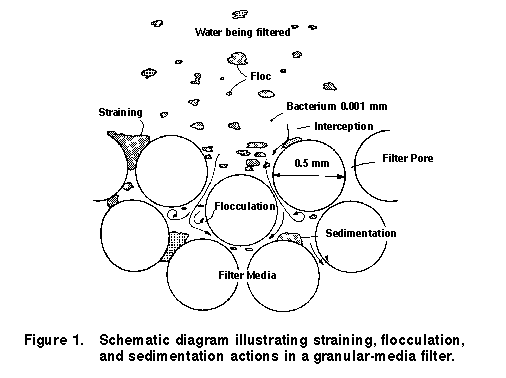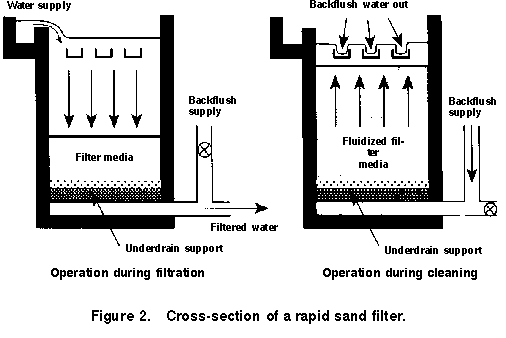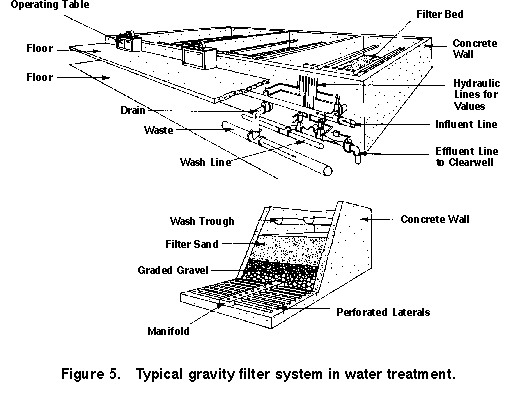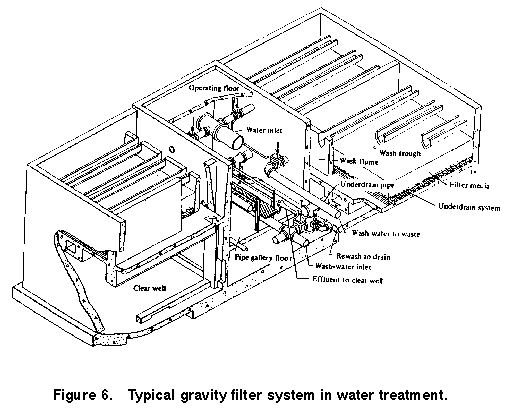![]()
Filtration is used to separate nonsettleable solids from water and wastewater by passing it through a porous medium. The most common system is filtration through a layered bed of granular media, usually a coarse anthracite coal underlain by a finer sand.
Filters may be classified according to the types of media used as follows:
| Single-media
filters: These have one type of media, usually sand or crushed anthracite coal. |
|
| Dual-media
filters: These have two types of media, usually crushed anthracite coal and sand.
|
|
| Multi-media filters: These have three types of media, usually crushed anthracite coal, sand, and garnet. |
In water treatment all three types are used; however, the dual- and multimedia filters are becoming increasingly popular. In advanced tertiary wastewater treatment, nearly all the filters are dual- or multimedia types.
Many particles in water are too small to remove by sedimentation alone. Filtration removes microorganisms and suspended matter from water not receiving sedimentation treatment, or it eliminates precipitated particles and flocs remaining after sedimentation. Filtration was actually developed prior to the discovery of the germ theory by Louis Pasteur in France. The first sand filter beds were constructed in the early 1800s in Great Britain.
Particle removal is accomplished only when the particles make physical contact with the surface of the filter medium. This may be the result of several mechanisms, as shown in Figure 1. Larger particles may be removed by straining. That is, the particle is larger than the pore, so it is trapped. Particles may also be removed by sedimentation as they progress through the filter. Others may be intercepted by and adhere to the surface of the medium due to inertia. Filtration efficiency is greatly increased by destabilization or coagulation of the particles prior to filtration. This reduction in the particle charge increases particle agglomeration and reduces the forces necessary to trap particles within the filter.
Gravity filtration through beds of granular media is the most common method removing colloidal impurities in water processing and tertiary treatment of wastewater.
The mechanisms involved in removing suspended solids in a granular-media filter are
complex, consisting of interception, straining, flocculation, and sedimentation as shown
schematically in Figure 1. Initially, surface straining and interstitial removal results
in accumulation of deposits in the upper portion of the filter media. Because of the
reduction in pore area, the velocity of water through the remaining voids increases,
shearing off pieces of capture floc and carrying impurities deeper into the filter bed.
The effective zone of removal passes deeper and deeper into the filter. Turbulence and the
resulting increased particle contact within the pores promotes flocculation, resulting in
trapping of the larger floc particles. Eventually, clean bed depth is no longer available
and breakthrough occurs, carrying solids out in the underflow and causing termination of
the filter run.

Microscopic particulate matter in raw water that has not been chemically treated will pass through the relatively larger pores of a filter bed. On the other hand, suspended solids fed to a filter with excess coagulant carryover from chemical treatment produces clogging of the bed pores at the surface. Optimum filtration occurs when impurities in the water and coagulant concentration cause "in-depth" filtration. The impurities neither pass through the bed nor are all strained out on the surface, but a significant amount of flocculated solids is removed throughout the entire depth of the filter.
Turbidity is a measurement of the clarity of water. It is predominantly used for potable water monitoring, although it is occasionally used to assess wastewater treatment processes. Clouded water is caused by suspended particles scattering or absorbing the light. Thus, turbidity is an indirect measurement of the amount of suspended matter in the water. However, since solids of different sizes, shapes, and surfaces reflect light differently, turbidity and suspended solids do not correlate well. Turbidity is normally gauged with an instrument that measures the amount of light scattered at an angle of 905 from a source beam. Turbidity is important in potable water because microorganisms attach to suspended particles.
The early filtration units developed in Great Britain used a process in which the hydraulic loading rate is relatively low. Typical slow sand filtration velocities are only about 0.4m/hr. At these low rates, the filtered contaminants do not penetrate to an appreciable depth within the filtration medium. The filter builds up a layer of filtered contaminants on the surface, which becomes the active filtering medium. This active filtration layer is termed a schmutzdecke. When the filter is first started after cleaning, the filtered water must be wasted until the filtration efficiency increases as the schmutzdecke is formed. Most of Europe has retained the lower loading rates (or slow sand filtration), whereas the United States developed and primarily uses rapid sand filtration.
Slow sand filters are cleaned by taking them off line and draining them. The organic or contaminant layer is then scraped off. The filter can then be restarted. After water quality reaches an acceptable level, the filter can then be put back on line.
In rapid sand filtration much higher application velocities are used. Filtration occurs
through the depth of the filter. A comparison of rapid and slow sand filtration is shown
in Table 1. In the United States, filter application rates are often expressed as
volumetric flowrate
per area, or gal/min-ft2, which is actually a velocity with atypical
units.
Table 1. Filtration Rates.
Filtration Type |
Application Rate |
|
m/hr |
gal/ft2-day |
|
Slow Sand |
0.04 to 0.4 |
340 to 3400 |
Rapid Sand |
0.4 to 3.1 |
3400 to 26,000 |
Figure 2 shows a typical rapid sand filter in normal operation. The water above the
filter provides the hydraulic head for the process. The filter medium is above a larger
gravel, rock, or other media for support. Below the rock is usually an underdrain support
of some type. This is simply a porous structure to support the filter medium. The water
flows through the filter and support media, exiting from a pipe below.

Most modern filters employ two separate filter media in layers. The lower layer is composed of a dense, fine media, often sand. The upper layer is composed of a less dense, coarse media, often anthracite coal. The coarse upper layer removes larger particles before they reach the fine layer, allowing the filter to operate for a longer period before clogging.
As the filter begins to clog from accumulated solids, less water will pass through it. At some point cleaning is required. Usual filter operation before cleaning is from a few hours to 2 days. Cleaning is accomplished by reversing the flow of water to the filter, or backwashing, as shown at the right in Figure 2. The backwash velocity is sufficient to fluidize the bed - that is, to suspend the bed with the reverse flow. After backwashing, the filter is again placed in operation. In larger plants, the backwashing operation is automatic. In smaller plants, the operation is often controlled by operating personnel.
A typical scheme for processing surface supplies to drinking-water quality, shown in
Figure 3, consists of flocculation with a chemical coagulant and sedimentation prior to
filtration. Under the force of gravity, often by a combination of positive head and
suction from underneath, water passes downward through the media that collect the floc and
particles. When the media become filled or solids break through, a filter bed is cleaned
by backwashing where upward flow fluidizes the media and conveys away the impurities that
have accumulated in the bed. Destruction of bacteria and viruses depends on satisfactory
turbidity control to enhance the efficiency of chlorination.

Filtration rates following flocculation and sedimentation are in the range of 2-10 gpm/ft2 (1.4-6.8 l/m2s) with 5 gpm/ft2 (3.4 l/m2s) normally the maximum design rate.
The process of direct filtration, diagrammed in Figure 4, does not include
sedimentation prior to filtration. The impurities removed from the water are collected and
stored in the filter. Although rapid mixing of chemicals is necessary, the flocculation
stage is either eliminated or reduced to a mixing time of less than 30 minutes. Contact
flocculation of the chemically coagulated particles in the water takes place in the
granular media. Successful advances in direct filtration are attributed to the development
of coarse-to-fine multimedia filters with greater capacity for "in-depth"
filtration, improved backwashing systems using mechanical or air agitation to aid cleaning
of the media, and the availability of better polymer coagulants.

Surface waters with low turbidity and color are most suitable for processing by direct filtration. Based on experiences cited in the literature, waters with less than 40 units of color, turbidity consistently below 5 units, iron and manganese concentrations of less than 0.3 and 0.05 mg/l, respectively and algal counts below 2000/ml can be successfully processed. Operational problems in direct filtration are expected when color exceeds 40 units or turbidity is greater than 15 units on a continuous basis. Potential problems can often be alleviated during a short period of time by application of additional polymer. Tertiary filtration of wastewaters containing 20-30 mg/l of suspended solids following biological treatment can be reduced to less than 5 mg/l by direct filtration. For inactivation of viruses and a high degree of bacterial disinfection, filtration of chemically conditioned wastewater precedes disinfection by chlorine.
The feasibility of filtration without prior flocculation and sedimentation relies on a comprehensive review of water quality data. The incidence of high turbidities caused by runoff from storms and blooms of algae must be evaluated. Often, pilot testing is valuable in determining efficiency of direct filtration compared to conventional treatment, design of filter media, and selection of chemical conditioning. Filtration rates in direct filtration are usually 1-6 gpm/ft2 (0.7-4.1 l/m^2s) somewhat lower than the rates following traditional pretreatment.
A cutaway view of a gravity filter is shown in Figure 4. During filtration, the water
enters above the filter media through an inlet flume. After passing downward through the
granular media (24-30 inches in thickness) and the supporting gravel bed, it is collected
in the underdrain system and discharged through the underdrain pipe. During backwashing,
wash water passing upward through the filter carries out the impurities that accumulated
in the media. After entering the underdrain pipe, it is distributed by the underdrain
flows upward, hydraulically expanding the filter media. The water is collected in the
wash-water troughs that discharge to the outlet flume. While backwashing, the agitator
arms rotate and spray water into the expanded bed to loosen any impurities that adhere to
the grains of filter media.

Typical construction of a gravity filter system in a water treatment plant is
illustrated in Figure 6. The filters are placed on both sides of a pipe gallery that
contains inlet and outlet piping, wash-water inlet lines, and wash-water drains. The
gallery is decked by an operating floor where control consoles are placed near the
filters. A clear well for storage of filtered water is located under a portion of the
filter bed area.

Broadly speaking, filter media should possess the following qualities:
These attributes are not a compatible. For example, a very fine sand retains floc, which also tends to shorten the filter run, while for a course sand the opposite would be true. Recent trends are toward coarse sands and dual-media beds of anthracite overlying sand so that high rates of filtration can be obtained.
A filter medium is defined by effective size and uniformity coefficient. The effective size is the 10-percentile diameter; that is, 10% by weight of the filter material is less than this diameter. The uniformity coefficient is the ratio of the 60-percentile size to the 10-percentile size. In water treatment, the conventional sand medium has an effective size of 0.45-0.55 mm, a uniformity coefficient less than 1.65, and a bed depth of 24-30 in. For dual-media filters, the top anthracite layer has an effective size of 0.8-1.2 mm, a uniformity coefficient of less than 1.85, thickness of a few inches to two thirds of the total filter thickness of 24-30 in., and is underlain by a sand filter layer as described above. The supporting coarse sand layer between the filter sand and the underlying gravel has an effective size of 0.8-2.0 mm and a uniformity coefficient less than 1.7. The coarsest layer of gravel required is determined by the kind of underdrain and size of openings for passage of filtered and backwash water.
A sand filter bed with a relatively uniform grain size can provide effective filtration throughout its depth. If the grain-size gradation is too great, effective filtering is confined to the upper few inches of sand. This results because the finest sand grains accumulate on the top of the bed during stratification after backwashing. The problem of surface plugging of sand filters led to development of dual-media filters. A dual-media filter consists of a sand [specific gravity (sg), 2.65] layer topped with a bed of anthracite coal medium (1.4 - 1.6 sg). The coarser anthracite top media layer pores about 20% larger than the sand medium. These openings are capable of adsorbing and trapping particles so that floc carried over in clarified water does not accumulate prematurely on the filter surface and plug the sand filter
Unconventional filters, are dual-media with coarse anthracite having an effective size of about 1.5 mm and a low uniformity coefficient to provide a greater volume of voids to collect impurities and extend filter runs of highly turbid surface waters and wastewaters. To avoid problems in backwashing, the recommended effective size of the underlying sand medium is 0.75 to 0.90 mm for anthracite densities of 1.45 to 1.65. The use of a single-medium coarse-sand filter is practiced in Europe. For example, sand with a size range of 0.9-1.5 mm and about 1.0 m depth has been used in surface-water treatment plants. These filters are scoured with concurrent air and water at nonfluidizing velocity followed by a brief wash at high velocity with water alone. Triple-media filters comprising anthracite, sand, and garnet layers have been used for many years in the United States. Both dual- and triple-media filters are substantially better than the conventional sand filter in providing longer filter runs with a corresponding reduction in required backwash water. In comparing these two filters, however, the benefit fit of adding a third layer has not been well demonstrated.
These filters, which have more than one medium, may be open gravity filters or pressure filters. In water treatment, they have become more popular in recent years. In advanced and tertiary waste treatment, they are the main type of filters that have been used successfully. Dual-media filter beds usually employ anthracite and sand; however, other materials have been used, such as activated carbon and sand. Multimedia filter beds generally use anthracite, sand, and garnet. However, other materials have been used, such as activated carbon, sand, and garnet. Also, dual- and multimedia filters using ion exchange resins as one of the media have been tried. In some of these filters, the media may have additional characteristics other than removing particles. For example, activated carbon removes dissolved organic substances.
The main advantages of multimedia filters compared to single-medium filters are longer filtration runs, higher filtration rates, and the ability to filter a water with higher turbidity and suspended solids. The advantages of the multimedia filters are due to:
These result in a filter with a larger percent of the pore volume being available for solids storage. In the single-medium filter, the pore volume available for solids storage is in the top portion of the bed, whereas in the multimedia filter, the available pore volume is extended deep within the filter bed. Because of the deep penetration of accumulated floc, these filters are frequently referred to as "deep bed filters." The single-medium filters are rarely used in wastewater or advanced wastewater treatment because of short filter runs. As a result of the large pore volume available for floc storage, the multimedia filters can be used in advanced or tertiary wastewater treatment and still have a reasonable filter run.
The dual-media filter, consisting of a layer of coarse anthracite coal above a layer of fine sand, is one technique for increasing the pore volume of a filter. Figure 7(b) shows the grain and pore size in a dual-media filter, and Figure 7(a) shows these characteristics for a single-medium filter. It can be seen from the pore size profile that the available pore volume of the dual-media filter will be greater than the single-medium filter. The available pore volume, however, will not be as large as the total pore volume because of the fine to coarse gradation within each layer. Ideally, the available pore volume would be maximum at the top of the filter and gradually decrease to a minimum at the bottom of the filter.
Usually, a dual-media filter consists of an 18- to 24-in. (457- to 610-mm) layer of crushed anthracite coal overlaying a 6- to 12-in. (152- to 305-mm) layer of sand. Coal has a specific gravity 1.2 to 1.6, and sand has a specific gravity of 2.65. During the first backwash, the sand layer remains below the coal as a result of its higher specific gravity and its grain size relative to the coal particles. After the first backwash, there will not be a distinct interface between the two layers, but instead there will be a blended region of both coal particles and sand grains.
The size and characteristics of the anthracite and sand media and the thickness of the layers depend upon whether the filter is to be used for water or wastewater treatment. Filtration rates may vary from 2 to 10gal/min-ft2 (1. 36 to 6 79 l/s-m2); however, a rate ranging from 3 to 6gal/min-ft2 (2,04 to 4.08 l/s-m2) is common.
The ideal filter has a pore size and gradation as shown in Figure 7(c). The pore size
is greatest at the top of the bed and gradually decreases to a minimum at the bottom. The
available pore volume, like the pore size, is maximum at the top of the bed and decreases
to a minimum at the bottom. The media have a gradation which is from coarse at the top to
fine at the bottom. The ideal filter may be approached by using a dual-media filter of
crushed anthracite coal above sand and placing a third, very dense media below the sand.
This allows the third medium to be very fine and still remain in the lower depths during
backwashing. The resulting filter is referred to as a mixed-media filter since there is
some intermixing between the layers during backwashing. Garnet, which has a specific
gravity of about 4.2, has been found to be ideal as the third medium. Ilmenite, having a
specific gravity of about 4.5, is also used but to a lesser extent. The anthracite, sand,
and gannet or ilmenite are properly sized to allow some intermixing of the media during
backwash. After backwashing there will be no distinct interface between the media layers.
The filter bed will approach the ideal, as shown in Figure 7(c), which has a gradual
decrease in pore size with increasing depth.

Since the pore size decreases from the top to the bottom of the filter, the filter will have a large available pore volume extending throughout the depth of the filter bed. About 3 in. (76mm) of coarse garnet or ilmenite is placed under the third layer to prevent fine particles from entering the underlaying gravel. The size and characteristic of the media and the thickness of the layers placed in the filter depend upon the type of service for the filter - that is, whether it is for water or wastewater treatment. The filtration rates that have been used in water treatment or advanced waste water treatment are from 2 to 12 gap/min-ft2 (1.36 to 8.15 l/s-m2); however, a rate ranging from 3 to 6 gal/min-ft2 (2.04 to 4.08 l/s-m2) is common.



![]()
This website was originally developed by Charles Camp for his CIVL 1101 class. This site is maintained by the Department of Civil Engineering at the University of Memphis. Your comments and questions are more than welcome.